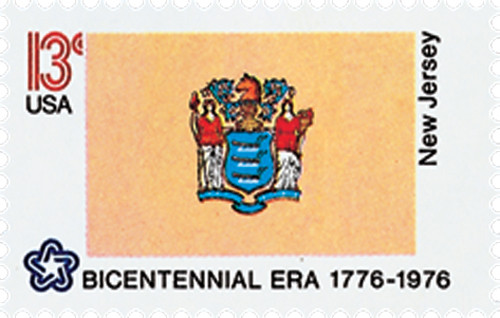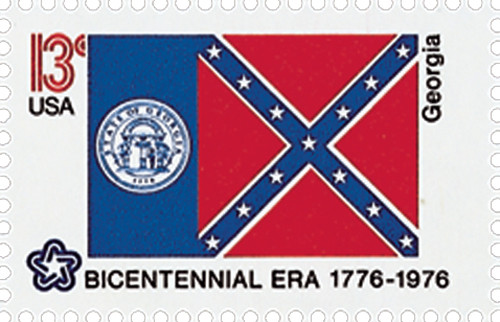
# 1669 - 1976 13c State Flags: Nebraska
U.S. 1669
1976 Nebraska
State Flags
American Bicentennial Series
• First time a sheet 50 had all different stamp designs
• Part of the American Bicentennial Series
Stamp Category: Commemorative
Series: American Bicentennial Series
Value: 13¢ First-class postage rate
First Day of Issue: February 23, 1976
First Day City(s): Washington, DC
Quantity Issued: 8,720,100 (panes of 50)
Printed by: Bureau of Engraving and Printing
Printing Method: Photogravure
Format: Sheet of 50
Perforations: 11
Why the stamp was issued:
The United States Postal Service celebrated the American Bicentennial with a full pane of the Union’s fifty state flags.
About the stamp design:
The Nebraska flag is blue with the state seal in gold and silver in the middle. Nebraska was the last state to adopt an official flag.
About the printing process:
Printed by the Bureau of Engraving and Printing on their seven-color Andreotti gravure press (601) which was their work horse for multicolored stamps.
About the American Bicentennial Series:
In the 1970s, America celebrated its 200th anniversary with hundreds of national events commemorating the heroes and historic events that led to our nation’s independence from Great Britain. The U.S. Postal Service issued 113 commemorative stamps over a six-year period in honor of the U.S. bicentennial, beginning with the American Revolution Bicentennial Commission Emblem stamp (U.S. #1432). As a group, the Bicentennial Series chronicles one of our nation’s most important chapters, and remembers the events and patriots who made the U.S. a world model for liberty.
Several of the stamps honored colonial life – craftsmen and communication. Other stamps honored important battles including Lexington and Concord, Bunker Hill, and Saratoga. Significant events such as the Boston Tea Party, the meeting of the First Continental Congress, and the Declaration of Independence were featured as well. The stamps also honored many significant people such as George Washington, Sybil Ludington, Salem Poor, and the Marquis de Lafayette.
Many of the stamps feature classic artwork. For instance, the set of four souvenir sheets picture important events recreated by noted artists such as John Trumbull. The Bicentennial Series also includes an important US postal first – the first 50-stamp se-tenant – featuring all 50 state flags. The format proved to be popular with collectors, and has been repeated many times since.
The American Bicentennial Series is packed with important US history – it tells the story of our nation’s fight for independence through stamps.
History the stamp represents:
Nebraska, whose residents chose to ban slavery, was admitted as a state in 1867
Inhabited by prehistoric people as early as 8000 B.C., Nebraska was ceded to the United States as part of the Louisiana Purchase.
On May 30, 1854, President Franklin Pierce signed the Kansas-Nebraska Act into law. The act had been created to settle tensions over slavery and open new lands for development, but instead only proved to create more division and move America closer to Civil War.
In the 1850s, Congress was deeply divided over the issue of slavery. This was particularly true over the fate of new US territories – there was a great struggle to see whether the practice of slavery would be allowed in the new territories or not. Earlier laws had been passed to address this. The Compromise of 1850 had, in part, left the issue of slavery up to the settlers of each territory (popular sovereignty). Additionally, the Missouri Compromise banned slavery in territories north of the 36°30′ parallel.
Stephen A. Douglas had been pushing for a transcontinental railroad since 1845. Part of his plan for the railroad involved organizing a formal Nebraska Territory. He submitted a proposal that passed in the House but was stalled in the Senate. Slavery wouldn’t have been allowed because the territory would have been north of 36°30′, but a group of senators refused to approve it if slavery wasn’t allowed.
The bill was reintroduced in early 1854. The amended bill would divide the former Nebraska Territory into two new territories – Kansas and Nebraska. The act would also allow residents of Kansas and Nebraska territories to decide for themselves whether to allow slavery within their borders. The act would also repeal the Missouri Compromise of 1820, which had banned slavery in most northwestern regions of the country.
The bill passed the Senate on March 4 and the House on May 22. President Franklin Pierce then signed it into law on May 30, 1854, officially establishing the Kansas and Nebraska Territories.
The Kansas-Nebraska Act outraged many Northerners. They considered the Missouri Compromise to have been binding. Many in the pro-slavery South supported the new act. Rather than stem the tide of war, the Kansas-Nebraska Act led to immediate hostilities. As the vote on slavery approached, abolitionists and pro-slavery factions rushed to the territories to influence the outcome.
In the first election, Kansas residents voted to allow slavery within their territory. Antislavery settlers alleged the vote was marred by fraud (more votes were counted than there were legitimate voters) and rejected the results. They held a second election, one in which the pro-slavery faction refused to vote. Each group established their own legislature within the territory, operating in direct opposition to the other.
Violence soon erupted between the pro-slavery Border Ruffians and the abolitionist Free-Staters. The death toll rose, leading to the phrase “Bleeding Kansas.” To support the pro-slavery settlers, President Franklin Pierce ordered Federal troops into the area to stop the violence and remove the abolitionist legislature. A third election was held. Pro-slavery supporters prevailed, and vote fraud was alleged once again.
As a result, Congress rejected the constitution adopted by the pro-slavery settlers and statehood was denied. Eventually, anti-slavery settlers in Kansas outnumbered pro-slavery residents, and statehood was granted shortly before the start of the Civil War. Kansas was admitted as a free state on January 29, 1861. Nebraska, whose residents chose to ban slavery, was admitted as a state in 1867.
U.S. 1669
1976 Nebraska
State Flags
American Bicentennial Series
• First time a sheet 50 had all different stamp designs
• Part of the American Bicentennial Series
Stamp Category: Commemorative
Series: American Bicentennial Series
Value: 13¢ First-class postage rate
First Day of Issue: February 23, 1976
First Day City(s): Washington, DC
Quantity Issued: 8,720,100 (panes of 50)
Printed by: Bureau of Engraving and Printing
Printing Method: Photogravure
Format: Sheet of 50
Perforations: 11
Why the stamp was issued:
The United States Postal Service celebrated the American Bicentennial with a full pane of the Union’s fifty state flags.
About the stamp design:
The Nebraska flag is blue with the state seal in gold and silver in the middle. Nebraska was the last state to adopt an official flag.
About the printing process:
Printed by the Bureau of Engraving and Printing on their seven-color Andreotti gravure press (601) which was their work horse for multicolored stamps.
About the American Bicentennial Series:
In the 1970s, America celebrated its 200th anniversary with hundreds of national events commemorating the heroes and historic events that led to our nation’s independence from Great Britain. The U.S. Postal Service issued 113 commemorative stamps over a six-year period in honor of the U.S. bicentennial, beginning with the American Revolution Bicentennial Commission Emblem stamp (U.S. #1432). As a group, the Bicentennial Series chronicles one of our nation’s most important chapters, and remembers the events and patriots who made the U.S. a world model for liberty.
Several of the stamps honored colonial life – craftsmen and communication. Other stamps honored important battles including Lexington and Concord, Bunker Hill, and Saratoga. Significant events such as the Boston Tea Party, the meeting of the First Continental Congress, and the Declaration of Independence were featured as well. The stamps also honored many significant people such as George Washington, Sybil Ludington, Salem Poor, and the Marquis de Lafayette.
Many of the stamps feature classic artwork. For instance, the set of four souvenir sheets picture important events recreated by noted artists such as John Trumbull. The Bicentennial Series also includes an important US postal first – the first 50-stamp se-tenant – featuring all 50 state flags. The format proved to be popular with collectors, and has been repeated many times since.
The American Bicentennial Series is packed with important US history – it tells the story of our nation’s fight for independence through stamps.
History the stamp represents:
Nebraska, whose residents chose to ban slavery, was admitted as a state in 1867
Inhabited by prehistoric people as early as 8000 B.C., Nebraska was ceded to the United States as part of the Louisiana Purchase.
On May 30, 1854, President Franklin Pierce signed the Kansas-Nebraska Act into law. The act had been created to settle tensions over slavery and open new lands for development, but instead only proved to create more division and move America closer to Civil War.
In the 1850s, Congress was deeply divided over the issue of slavery. This was particularly true over the fate of new US territories – there was a great struggle to see whether the practice of slavery would be allowed in the new territories or not. Earlier laws had been passed to address this. The Compromise of 1850 had, in part, left the issue of slavery up to the settlers of each territory (popular sovereignty). Additionally, the Missouri Compromise banned slavery in territories north of the 36°30′ parallel.
Stephen A. Douglas had been pushing for a transcontinental railroad since 1845. Part of his plan for the railroad involved organizing a formal Nebraska Territory. He submitted a proposal that passed in the House but was stalled in the Senate. Slavery wouldn’t have been allowed because the territory would have been north of 36°30′, but a group of senators refused to approve it if slavery wasn’t allowed.
The bill was reintroduced in early 1854. The amended bill would divide the former Nebraska Territory into two new territories – Kansas and Nebraska. The act would also allow residents of Kansas and Nebraska territories to decide for themselves whether to allow slavery within their borders. The act would also repeal the Missouri Compromise of 1820, which had banned slavery in most northwestern regions of the country.
The bill passed the Senate on March 4 and the House on May 22. President Franklin Pierce then signed it into law on May 30, 1854, officially establishing the Kansas and Nebraska Territories.
The Kansas-Nebraska Act outraged many Northerners. They considered the Missouri Compromise to have been binding. Many in the pro-slavery South supported the new act. Rather than stem the tide of war, the Kansas-Nebraska Act led to immediate hostilities. As the vote on slavery approached, abolitionists and pro-slavery factions rushed to the territories to influence the outcome.
In the first election, Kansas residents voted to allow slavery within their territory. Antislavery settlers alleged the vote was marred by fraud (more votes were counted than there were legitimate voters) and rejected the results. They held a second election, one in which the pro-slavery faction refused to vote. Each group established their own legislature within the territory, operating in direct opposition to the other.
Violence soon erupted between the pro-slavery Border Ruffians and the abolitionist Free-Staters. The death toll rose, leading to the phrase “Bleeding Kansas.” To support the pro-slavery settlers, President Franklin Pierce ordered Federal troops into the area to stop the violence and remove the abolitionist legislature. A third election was held. Pro-slavery supporters prevailed, and vote fraud was alleged once again.
As a result, Congress rejected the constitution adopted by the pro-slavery settlers and statehood was denied. Eventually, anti-slavery settlers in Kansas outnumbered pro-slavery residents, and statehood was granted shortly before the start of the Civil War. Kansas was admitted as a free state on January 29, 1861. Nebraska, whose residents chose to ban slavery, was admitted as a state in 1867.


















